Essay: Religion, State, and Global Society in Post-Cold War Era
VerifiedAdded on 2021/05/31
|7
|1825
|276
Essay
AI Summary
This essay delves into the multifaceted relationship between religion, the state, and global society. It begins by defining religious fundamentalism and contrasting it with modernity, exploring its rise and impact. The essay then examines the core claims of the 'New' Atheists, comparing and contrasting their views with those of religious fundamentalists. It critically assesses the claim that religion is inherently violent, considering historical and contemporary examples. Further, the essay analyzes the conditions under which religious actors support democratization and explores Juergensmeyer's argument that religion and secular nationalism are competing ideologies. Finally, it investigates the patterns observed in international relations as religion interacts with global forces of integration and disintegration in the post-Cold War period, offering a comprehensive analysis of the subject.
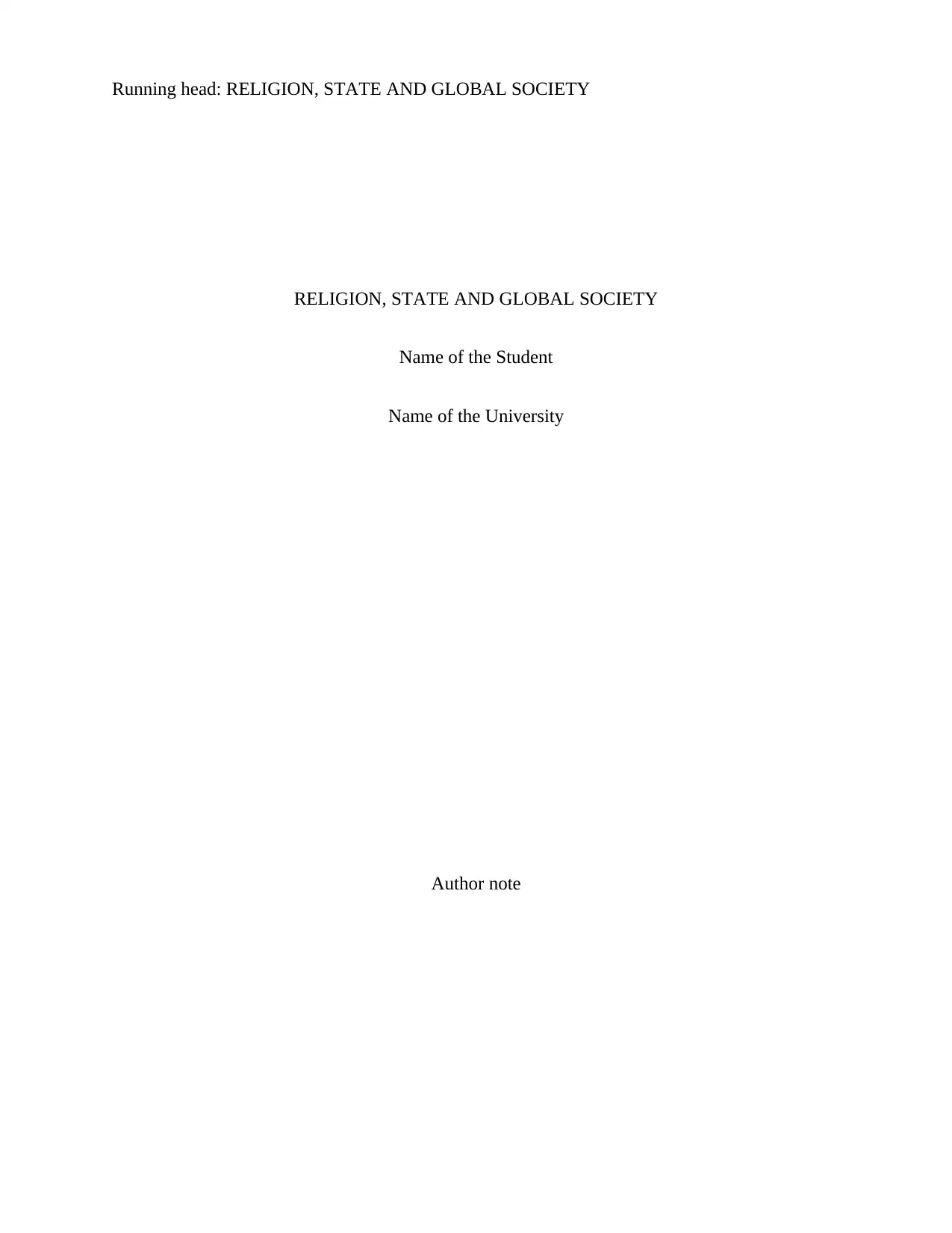
Running head: RELIGION, STATE AND GLOBAL SOCIETY
RELIGION, STATE AND GLOBAL SOCIETY
Name of the Student
Name of the University
Author note
RELIGION, STATE AND GLOBAL SOCIETY
Name of the Student
Name of the University
Author note
Paraphrase This Document
Need a fresh take? Get an instant paraphrase of this document with our AI Paraphraser
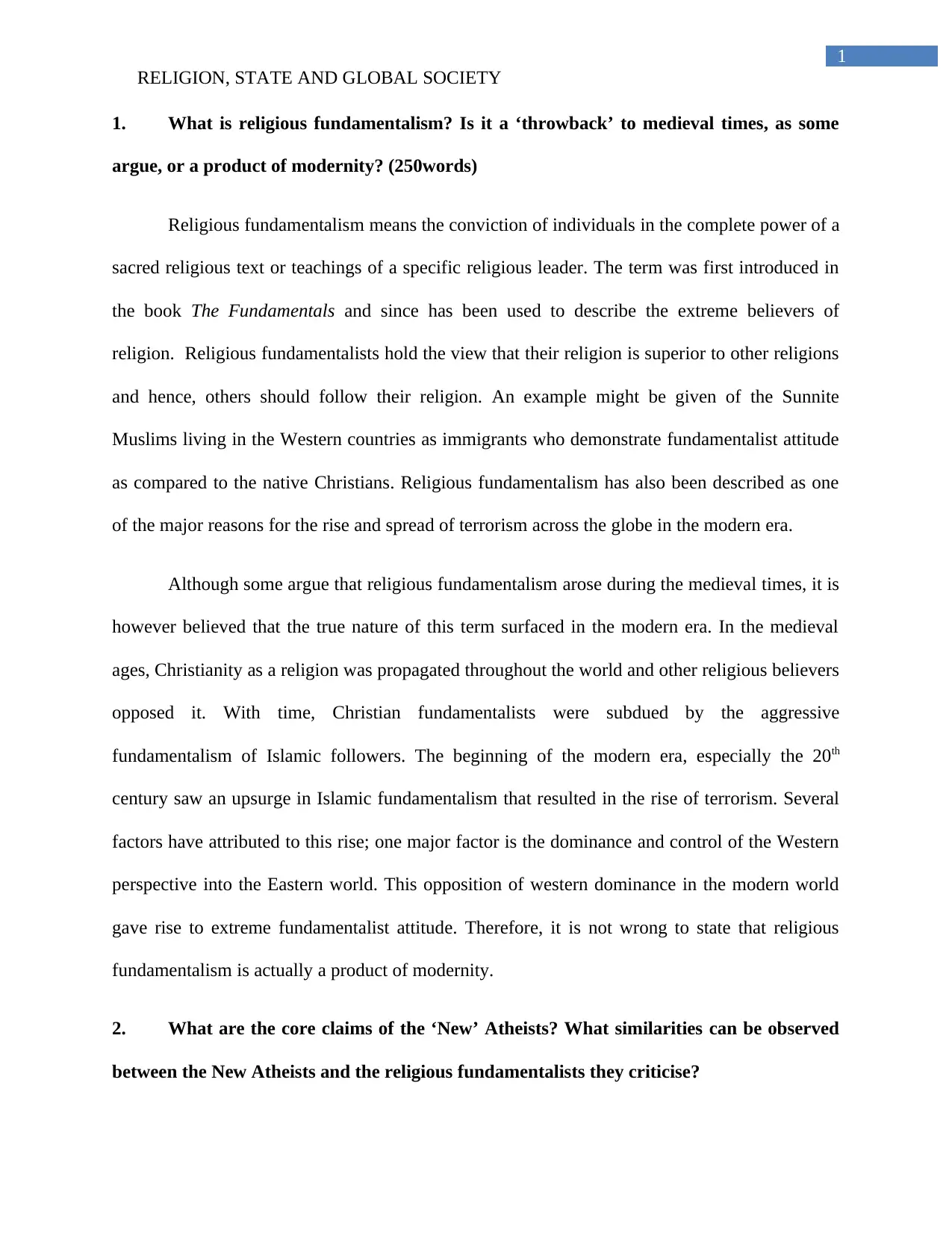
1
RELIGION, STATE AND GLOBAL SOCIETY
1. What is religious fundamentalism? Is it a ‘throwback’ to medieval times, as some
argue, or a product of modernity? (250words)
Religious fundamentalism means the conviction of individuals in the complete power of a
sacred religious text or teachings of a specific religious leader. The term was first introduced in
the book The Fundamentals and since has been used to describe the extreme believers of
religion. Religious fundamentalists hold the view that their religion is superior to other religions
and hence, others should follow their religion. An example might be given of the Sunnite
Muslims living in the Western countries as immigrants who demonstrate fundamentalist attitude
as compared to the native Christians. Religious fundamentalism has also been described as one
of the major reasons for the rise and spread of terrorism across the globe in the modern era.
Although some argue that religious fundamentalism arose during the medieval times, it is
however believed that the true nature of this term surfaced in the modern era. In the medieval
ages, Christianity as a religion was propagated throughout the world and other religious believers
opposed it. With time, Christian fundamentalists were subdued by the aggressive
fundamentalism of Islamic followers. The beginning of the modern era, especially the 20th
century saw an upsurge in Islamic fundamentalism that resulted in the rise of terrorism. Several
factors have attributed to this rise; one major factor is the dominance and control of the Western
perspective into the Eastern world. This opposition of western dominance in the modern world
gave rise to extreme fundamentalist attitude. Therefore, it is not wrong to state that religious
fundamentalism is actually a product of modernity.
2. What are the core claims of the ‘New’ Atheists? What similarities can be observed
between the New Atheists and the religious fundamentalists they criticise?
RELIGION, STATE AND GLOBAL SOCIETY
1. What is religious fundamentalism? Is it a ‘throwback’ to medieval times, as some
argue, or a product of modernity? (250words)
Religious fundamentalism means the conviction of individuals in the complete power of a
sacred religious text or teachings of a specific religious leader. The term was first introduced in
the book The Fundamentals and since has been used to describe the extreme believers of
religion. Religious fundamentalists hold the view that their religion is superior to other religions
and hence, others should follow their religion. An example might be given of the Sunnite
Muslims living in the Western countries as immigrants who demonstrate fundamentalist attitude
as compared to the native Christians. Religious fundamentalism has also been described as one
of the major reasons for the rise and spread of terrorism across the globe in the modern era.
Although some argue that religious fundamentalism arose during the medieval times, it is
however believed that the true nature of this term surfaced in the modern era. In the medieval
ages, Christianity as a religion was propagated throughout the world and other religious believers
opposed it. With time, Christian fundamentalists were subdued by the aggressive
fundamentalism of Islamic followers. The beginning of the modern era, especially the 20th
century saw an upsurge in Islamic fundamentalism that resulted in the rise of terrorism. Several
factors have attributed to this rise; one major factor is the dominance and control of the Western
perspective into the Eastern world. This opposition of western dominance in the modern world
gave rise to extreme fundamentalist attitude. Therefore, it is not wrong to state that religious
fundamentalism is actually a product of modernity.
2. What are the core claims of the ‘New’ Atheists? What similarities can be observed
between the New Atheists and the religious fundamentalists they criticise?
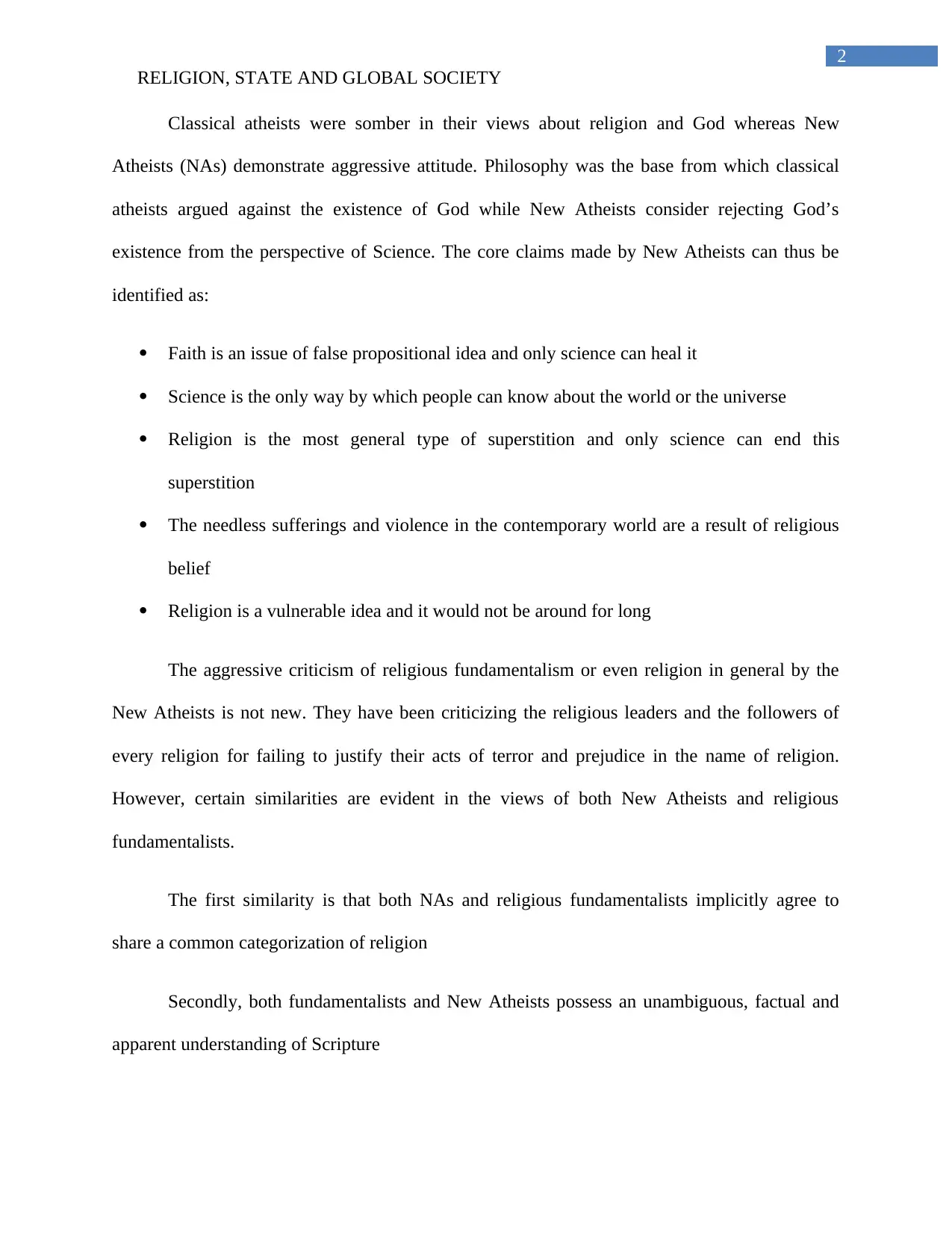
2
RELIGION, STATE AND GLOBAL SOCIETY
Classical atheists were somber in their views about religion and God whereas New
Atheists (NAs) demonstrate aggressive attitude. Philosophy was the base from which classical
atheists argued against the existence of God while New Atheists consider rejecting God’s
existence from the perspective of Science. The core claims made by New Atheists can thus be
identified as:
Faith is an issue of false propositional idea and only science can heal it
Science is the only way by which people can know about the world or the universe
Religion is the most general type of superstition and only science can end this
superstition
The needless sufferings and violence in the contemporary world are a result of religious
belief
Religion is a vulnerable idea and it would not be around for long
The aggressive criticism of religious fundamentalism or even religion in general by the
New Atheists is not new. They have been criticizing the religious leaders and the followers of
every religion for failing to justify their acts of terror and prejudice in the name of religion.
However, certain similarities are evident in the views of both New Atheists and religious
fundamentalists.
The first similarity is that both NAs and religious fundamentalists implicitly agree to
share a common categorization of religion
Secondly, both fundamentalists and New Atheists possess an unambiguous, factual and
apparent understanding of Scripture
RELIGION, STATE AND GLOBAL SOCIETY
Classical atheists were somber in their views about religion and God whereas New
Atheists (NAs) demonstrate aggressive attitude. Philosophy was the base from which classical
atheists argued against the existence of God while New Atheists consider rejecting God’s
existence from the perspective of Science. The core claims made by New Atheists can thus be
identified as:
Faith is an issue of false propositional idea and only science can heal it
Science is the only way by which people can know about the world or the universe
Religion is the most general type of superstition and only science can end this
superstition
The needless sufferings and violence in the contemporary world are a result of religious
belief
Religion is a vulnerable idea and it would not be around for long
The aggressive criticism of religious fundamentalism or even religion in general by the
New Atheists is not new. They have been criticizing the religious leaders and the followers of
every religion for failing to justify their acts of terror and prejudice in the name of religion.
However, certain similarities are evident in the views of both New Atheists and religious
fundamentalists.
The first similarity is that both NAs and religious fundamentalists implicitly agree to
share a common categorization of religion
Secondly, both fundamentalists and New Atheists possess an unambiguous, factual and
apparent understanding of Scripture
⊘ This is a preview!⊘
Do you want full access?
Subscribe today to unlock all pages.

Trusted by 1+ million students worldwide
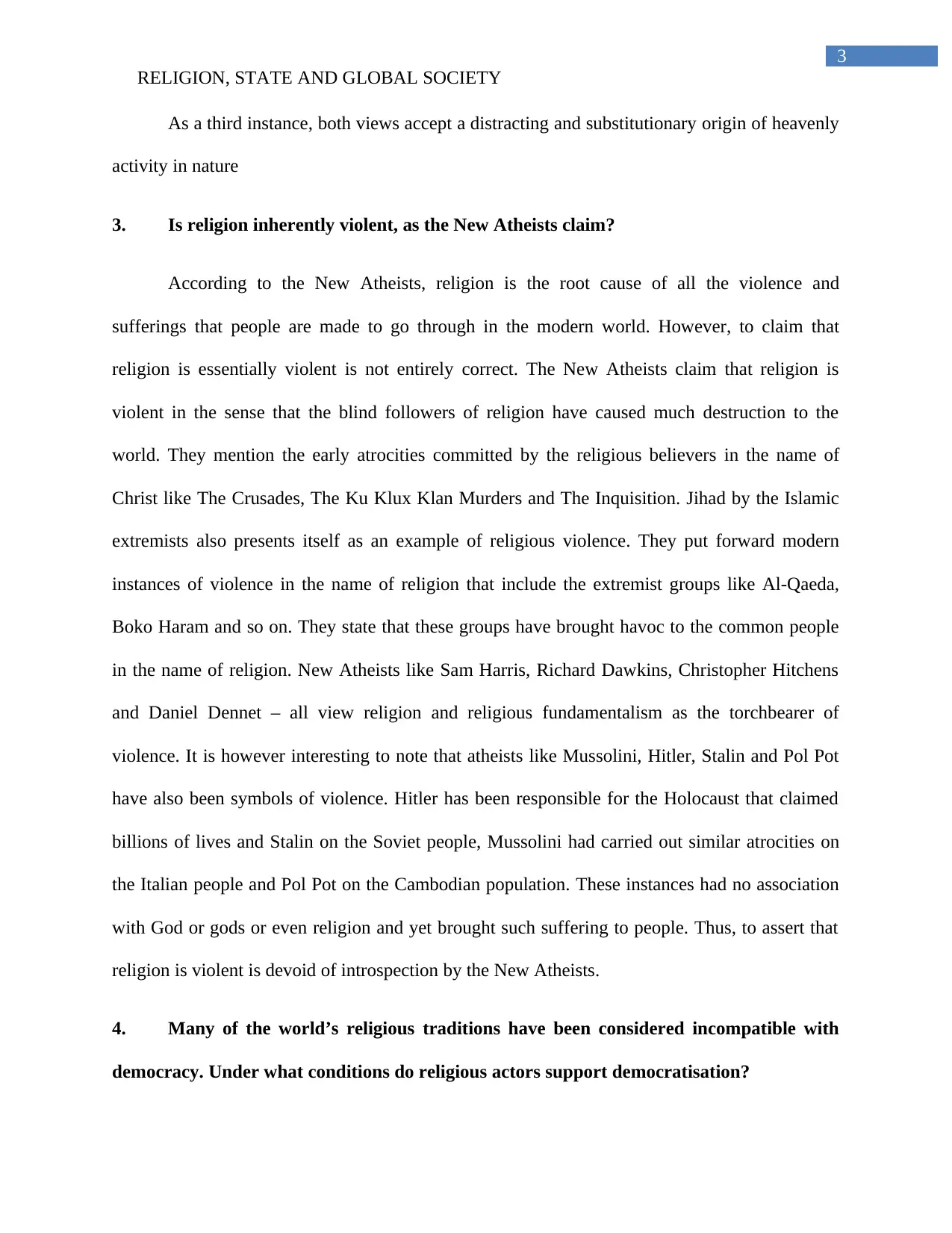
3
RELIGION, STATE AND GLOBAL SOCIETY
As a third instance, both views accept a distracting and substitutionary origin of heavenly
activity in nature
3. Is religion inherently violent, as the New Atheists claim?
According to the New Atheists, religion is the root cause of all the violence and
sufferings that people are made to go through in the modern world. However, to claim that
religion is essentially violent is not entirely correct. The New Atheists claim that religion is
violent in the sense that the blind followers of religion have caused much destruction to the
world. They mention the early atrocities committed by the religious believers in the name of
Christ like The Crusades, The Ku Klux Klan Murders and The Inquisition. Jihad by the Islamic
extremists also presents itself as an example of religious violence. They put forward modern
instances of violence in the name of religion that include the extremist groups like Al-Qaeda,
Boko Haram and so on. They state that these groups have brought havoc to the common people
in the name of religion. New Atheists like Sam Harris, Richard Dawkins, Christopher Hitchens
and Daniel Dennet – all view religion and religious fundamentalism as the torchbearer of
violence. It is however interesting to note that atheists like Mussolini, Hitler, Stalin and Pol Pot
have also been symbols of violence. Hitler has been responsible for the Holocaust that claimed
billions of lives and Stalin on the Soviet people, Mussolini had carried out similar atrocities on
the Italian people and Pol Pot on the Cambodian population. These instances had no association
with God or gods or even religion and yet brought such suffering to people. Thus, to assert that
religion is violent is devoid of introspection by the New Atheists.
4. Many of the world’s religious traditions have been considered incompatible with
democracy. Under what conditions do religious actors support democratisation?
RELIGION, STATE AND GLOBAL SOCIETY
As a third instance, both views accept a distracting and substitutionary origin of heavenly
activity in nature
3. Is religion inherently violent, as the New Atheists claim?
According to the New Atheists, religion is the root cause of all the violence and
sufferings that people are made to go through in the modern world. However, to claim that
religion is essentially violent is not entirely correct. The New Atheists claim that religion is
violent in the sense that the blind followers of religion have caused much destruction to the
world. They mention the early atrocities committed by the religious believers in the name of
Christ like The Crusades, The Ku Klux Klan Murders and The Inquisition. Jihad by the Islamic
extremists also presents itself as an example of religious violence. They put forward modern
instances of violence in the name of religion that include the extremist groups like Al-Qaeda,
Boko Haram and so on. They state that these groups have brought havoc to the common people
in the name of religion. New Atheists like Sam Harris, Richard Dawkins, Christopher Hitchens
and Daniel Dennet – all view religion and religious fundamentalism as the torchbearer of
violence. It is however interesting to note that atheists like Mussolini, Hitler, Stalin and Pol Pot
have also been symbols of violence. Hitler has been responsible for the Holocaust that claimed
billions of lives and Stalin on the Soviet people, Mussolini had carried out similar atrocities on
the Italian people and Pol Pot on the Cambodian population. These instances had no association
with God or gods or even religion and yet brought such suffering to people. Thus, to assert that
religion is violent is devoid of introspection by the New Atheists.
4. Many of the world’s religious traditions have been considered incompatible with
democracy. Under what conditions do religious actors support democratisation?
Paraphrase This Document
Need a fresh take? Get an instant paraphrase of this document with our AI Paraphraser
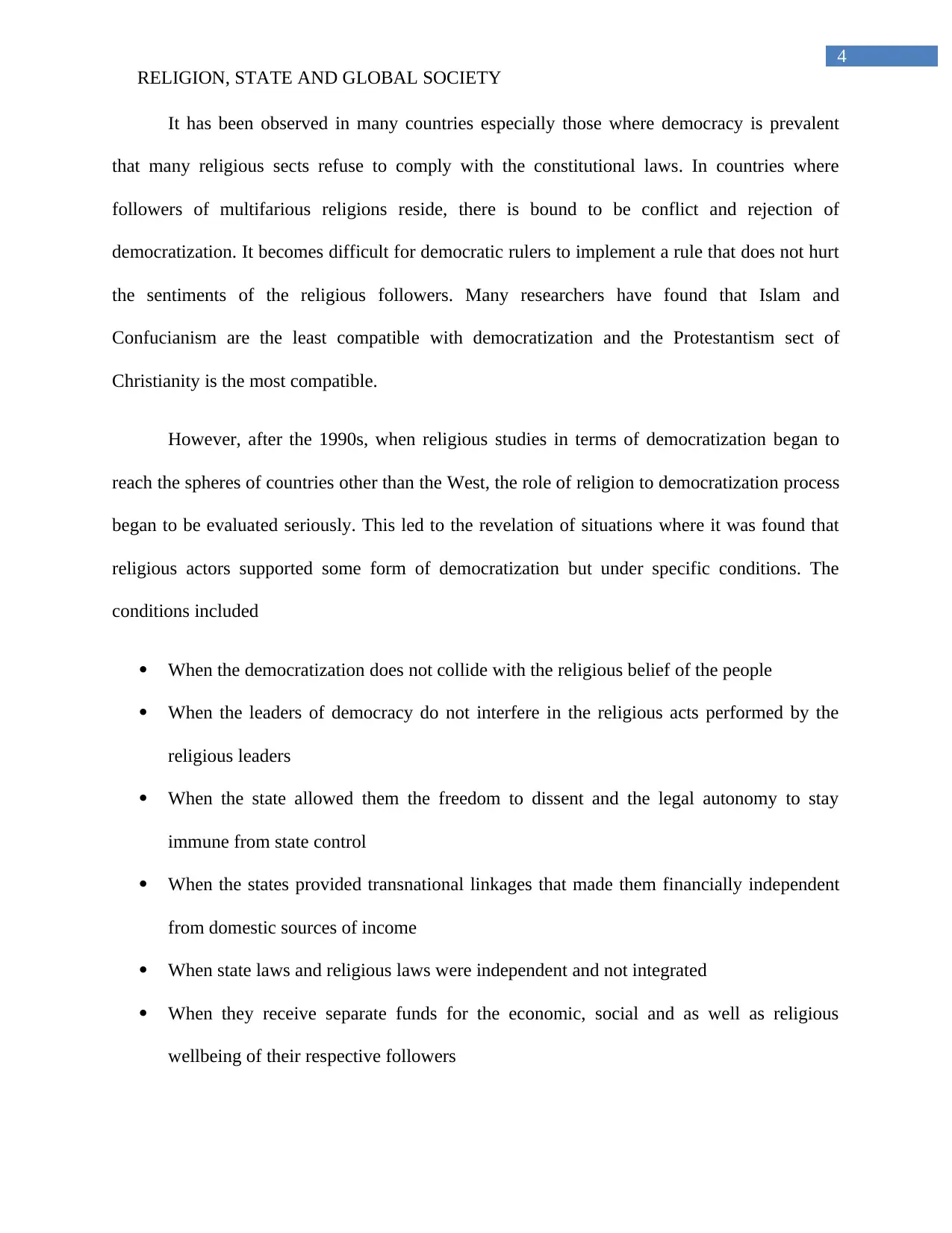
4
RELIGION, STATE AND GLOBAL SOCIETY
It has been observed in many countries especially those where democracy is prevalent
that many religious sects refuse to comply with the constitutional laws. In countries where
followers of multifarious religions reside, there is bound to be conflict and rejection of
democratization. It becomes difficult for democratic rulers to implement a rule that does not hurt
the sentiments of the religious followers. Many researchers have found that Islam and
Confucianism are the least compatible with democratization and the Protestantism sect of
Christianity is the most compatible.
However, after the 1990s, when religious studies in terms of democratization began to
reach the spheres of countries other than the West, the role of religion to democratization process
began to be evaluated seriously. This led to the revelation of situations where it was found that
religious actors supported some form of democratization but under specific conditions. The
conditions included
When the democratization does not collide with the religious belief of the people
When the leaders of democracy do not interfere in the religious acts performed by the
religious leaders
When the state allowed them the freedom to dissent and the legal autonomy to stay
immune from state control
When the states provided transnational linkages that made them financially independent
from domestic sources of income
When state laws and religious laws were independent and not integrated
When they receive separate funds for the economic, social and as well as religious
wellbeing of their respective followers
RELIGION, STATE AND GLOBAL SOCIETY
It has been observed in many countries especially those where democracy is prevalent
that many religious sects refuse to comply with the constitutional laws. In countries where
followers of multifarious religions reside, there is bound to be conflict and rejection of
democratization. It becomes difficult for democratic rulers to implement a rule that does not hurt
the sentiments of the religious followers. Many researchers have found that Islam and
Confucianism are the least compatible with democratization and the Protestantism sect of
Christianity is the most compatible.
However, after the 1990s, when religious studies in terms of democratization began to
reach the spheres of countries other than the West, the role of religion to democratization process
began to be evaluated seriously. This led to the revelation of situations where it was found that
religious actors supported some form of democratization but under specific conditions. The
conditions included
When the democratization does not collide with the religious belief of the people
When the leaders of democracy do not interfere in the religious acts performed by the
religious leaders
When the state allowed them the freedom to dissent and the legal autonomy to stay
immune from state control
When the states provided transnational linkages that made them financially independent
from domestic sources of income
When state laws and religious laws were independent and not integrated
When they receive separate funds for the economic, social and as well as religious
wellbeing of their respective followers
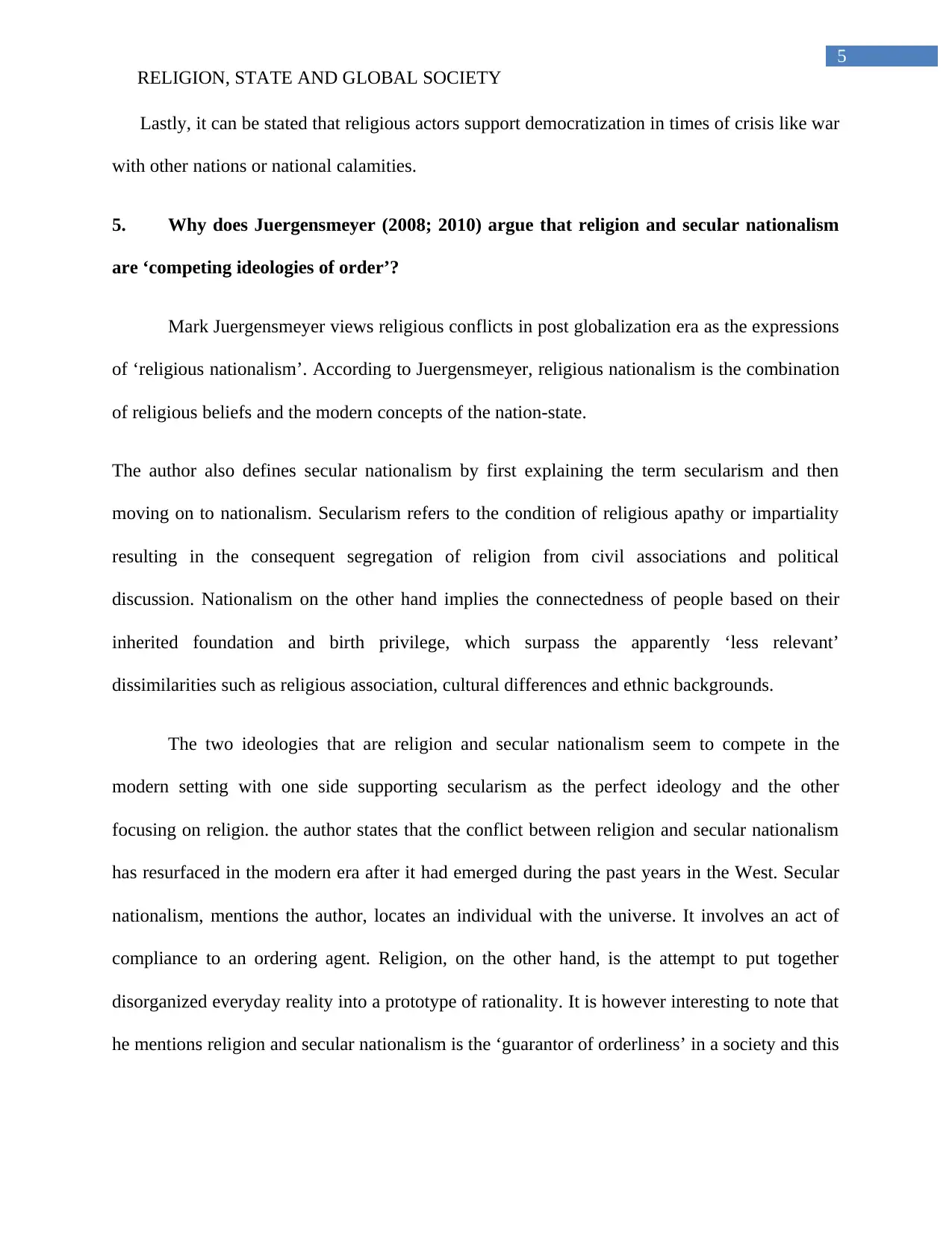
5
RELIGION, STATE AND GLOBAL SOCIETY
Lastly, it can be stated that religious actors support democratization in times of crisis like war
with other nations or national calamities.
5. Why does Juergensmeyer (2008; 2010) argue that religion and secular nationalism
are ‘competing ideologies of order’?
Mark Juergensmeyer views religious conflicts in post globalization era as the expressions
of ‘religious nationalism’. According to Juergensmeyer, religious nationalism is the combination
of religious beliefs and the modern concepts of the nation-state.
The author also defines secular nationalism by first explaining the term secularism and then
moving on to nationalism. Secularism refers to the condition of religious apathy or impartiality
resulting in the consequent segregation of religion from civil associations and political
discussion. Nationalism on the other hand implies the connectedness of people based on their
inherited foundation and birth privilege, which surpass the apparently ‘less relevant’
dissimilarities such as religious association, cultural differences and ethnic backgrounds.
The two ideologies that are religion and secular nationalism seem to compete in the
modern setting with one side supporting secularism as the perfect ideology and the other
focusing on religion. the author states that the conflict between religion and secular nationalism
has resurfaced in the modern era after it had emerged during the past years in the West. Secular
nationalism, mentions the author, locates an individual with the universe. It involves an act of
compliance to an ordering agent. Religion, on the other hand, is the attempt to put together
disorganized everyday reality into a prototype of rationality. It is however interesting to note that
he mentions religion and secular nationalism is the ‘guarantor of orderliness’ in a society and this
RELIGION, STATE AND GLOBAL SOCIETY
Lastly, it can be stated that religious actors support democratization in times of crisis like war
with other nations or national calamities.
5. Why does Juergensmeyer (2008; 2010) argue that religion and secular nationalism
are ‘competing ideologies of order’?
Mark Juergensmeyer views religious conflicts in post globalization era as the expressions
of ‘religious nationalism’. According to Juergensmeyer, religious nationalism is the combination
of religious beliefs and the modern concepts of the nation-state.
The author also defines secular nationalism by first explaining the term secularism and then
moving on to nationalism. Secularism refers to the condition of religious apathy or impartiality
resulting in the consequent segregation of religion from civil associations and political
discussion. Nationalism on the other hand implies the connectedness of people based on their
inherited foundation and birth privilege, which surpass the apparently ‘less relevant’
dissimilarities such as religious association, cultural differences and ethnic backgrounds.
The two ideologies that are religion and secular nationalism seem to compete in the
modern setting with one side supporting secularism as the perfect ideology and the other
focusing on religion. the author states that the conflict between religion and secular nationalism
has resurfaced in the modern era after it had emerged during the past years in the West. Secular
nationalism, mentions the author, locates an individual with the universe. It involves an act of
compliance to an ordering agent. Religion, on the other hand, is the attempt to put together
disorganized everyday reality into a prototype of rationality. It is however interesting to note that
he mentions religion and secular nationalism is the ‘guarantor of orderliness’ in a society and this
⊘ This is a preview!⊘
Do you want full access?
Subscribe today to unlock all pages.

Trusted by 1+ million students worldwide
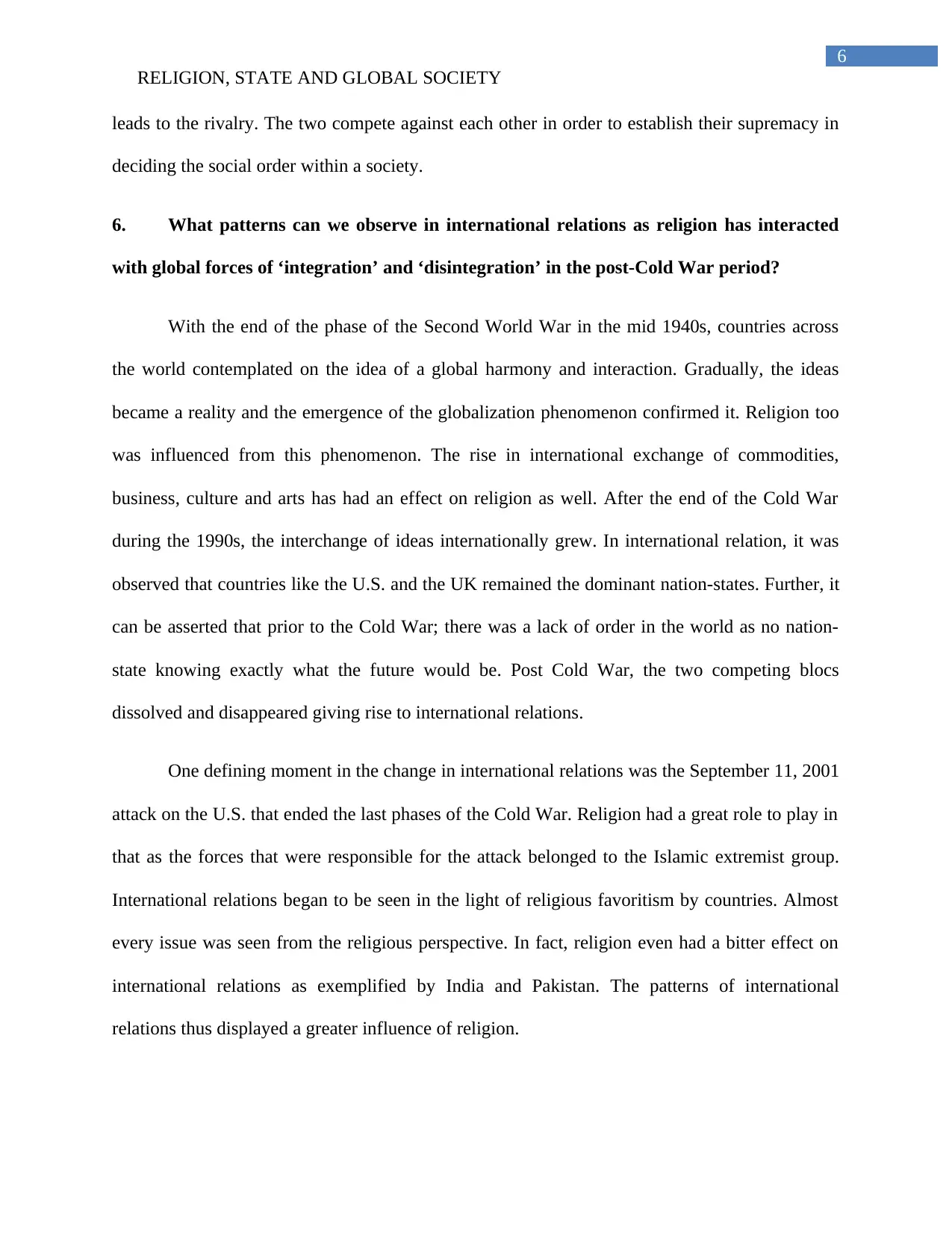
6
RELIGION, STATE AND GLOBAL SOCIETY
leads to the rivalry. The two compete against each other in order to establish their supremacy in
deciding the social order within a society.
6. What patterns can we observe in international relations as religion has interacted
with global forces of ‘integration’ and ‘disintegration’ in the post-Cold War period?
With the end of the phase of the Second World War in the mid 1940s, countries across
the world contemplated on the idea of a global harmony and interaction. Gradually, the ideas
became a reality and the emergence of the globalization phenomenon confirmed it. Religion too
was influenced from this phenomenon. The rise in international exchange of commodities,
business, culture and arts has had an effect on religion as well. After the end of the Cold War
during the 1990s, the interchange of ideas internationally grew. In international relation, it was
observed that countries like the U.S. and the UK remained the dominant nation-states. Further, it
can be asserted that prior to the Cold War; there was a lack of order in the world as no nation-
state knowing exactly what the future would be. Post Cold War, the two competing blocs
dissolved and disappeared giving rise to international relations.
One defining moment in the change in international relations was the September 11, 2001
attack on the U.S. that ended the last phases of the Cold War. Religion had a great role to play in
that as the forces that were responsible for the attack belonged to the Islamic extremist group.
International relations began to be seen in the light of religious favoritism by countries. Almost
every issue was seen from the religious perspective. In fact, religion even had a bitter effect on
international relations as exemplified by India and Pakistan. The patterns of international
relations thus displayed a greater influence of religion.
RELIGION, STATE AND GLOBAL SOCIETY
leads to the rivalry. The two compete against each other in order to establish their supremacy in
deciding the social order within a society.
6. What patterns can we observe in international relations as religion has interacted
with global forces of ‘integration’ and ‘disintegration’ in the post-Cold War period?
With the end of the phase of the Second World War in the mid 1940s, countries across
the world contemplated on the idea of a global harmony and interaction. Gradually, the ideas
became a reality and the emergence of the globalization phenomenon confirmed it. Religion too
was influenced from this phenomenon. The rise in international exchange of commodities,
business, culture and arts has had an effect on religion as well. After the end of the Cold War
during the 1990s, the interchange of ideas internationally grew. In international relation, it was
observed that countries like the U.S. and the UK remained the dominant nation-states. Further, it
can be asserted that prior to the Cold War; there was a lack of order in the world as no nation-
state knowing exactly what the future would be. Post Cold War, the two competing blocs
dissolved and disappeared giving rise to international relations.
One defining moment in the change in international relations was the September 11, 2001
attack on the U.S. that ended the last phases of the Cold War. Religion had a great role to play in
that as the forces that were responsible for the attack belonged to the Islamic extremist group.
International relations began to be seen in the light of religious favoritism by countries. Almost
every issue was seen from the religious perspective. In fact, religion even had a bitter effect on
international relations as exemplified by India and Pakistan. The patterns of international
relations thus displayed a greater influence of religion.
1 out of 7
Related Documents
Your All-in-One AI-Powered Toolkit for Academic Success.
+13062052269
info@desklib.com
Available 24*7 on WhatsApp / Email
![[object Object]](/_next/static/media/star-bottom.7253800d.svg)
Unlock your academic potential
Copyright © 2020–2025 A2Z Services. All Rights Reserved. Developed and managed by ZUCOL.
![Religion is Violent: A New Atheist Perspective - [University Name]](/_next/image/?url=https%3A%2F%2Fdesklib.com%2Fmedia%2Fimages%2Fml%2F2f05453306514aec9e859d7223784db1.jpg&w=256&q=75)




